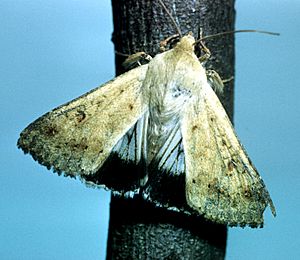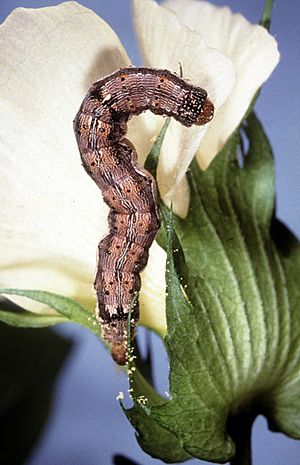Native budworm facts for kids
Quick facts for kids Native budworm |
|
|---|---|
 |
|
 |
|
| Scientific classification | |
| Kingdom: | |
| Phylum: | |
| Class: | |
| Order: | |
| Family: | |
| Genus: |
Helicoverpa
|
| Species: |
H. punctigera
|
| Binomial name | |
| Helicoverpa punctigera (Wallengren, 1860)
|
|
| Synonyms | |
|
|
The native budworm or Australian bollworm (scientific name: Helicoverpa punctigera) is a type of moth. It belongs to the Noctuidae family, which includes many kinds of night-flying moths. This moth is originally from Australia.
These moths are known for traveling long distances. They can fly from inland parts of Australia all the way to coastal areas. Sometimes, they even fly across the sea to New Zealand! Adult moths usually live for about 11 to 18 days in a lab setting. Their wingspan is around 40 millimeters (about 1.5 inches).
The native budworm is a "generalist feeder." This means its young, called larvae or caterpillars, can eat many different kinds of plants. They have been seen eating over 100 plant species! Because they eat so many plants, they are often considered a pest for important crops like tobacco, flax, peas, sunflower, cotton, maize, and tomatoes. Outside of farms, they also like to eat native Australian daisies and a plant called Cullen cinereum.
What the Native Budworm Looks Like
Eggs
The eggs of the native budworm are shaped like tiny balls. Their color changes as the larva inside grows. When first laid, the eggs are white. They then turn brown, and just before the larva hatches, they become black.
Larvae (Caterpillars)
Native budworm larvae are caterpillars. They usually have a brown or black head. Their body is yellowish-white and has dark spots. These larvae can grow quite large, reaching about 29 to 30 millimeters (just over an inch) long by the time they are fully grown.
See also
 In Spanish: Helicoverpa punctigera para niños
In Spanish: Helicoverpa punctigera para niños

